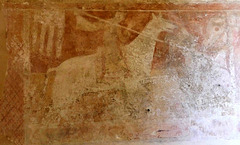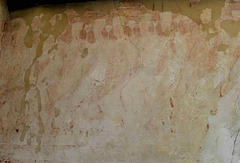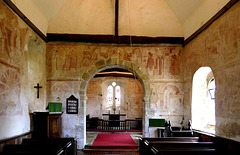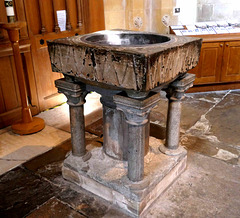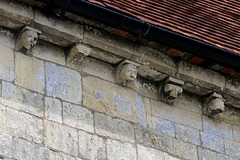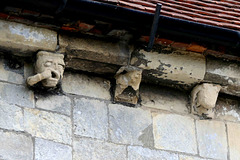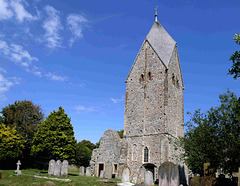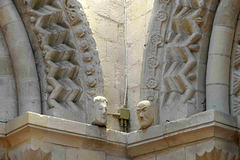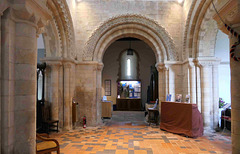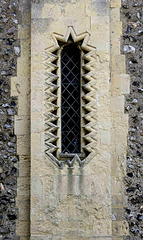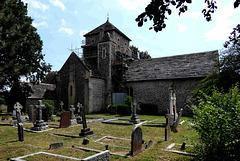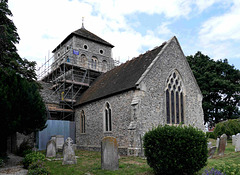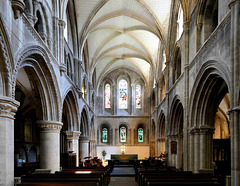Martin M. Miles' photos
Hardham - St Botolph
| |
|
|
St Botolph's Church in Hardham is late Saxon or early Norman. It is considered to be 11th century and was complete by 1125 at the latest. The dedication to St Botolph is generally associated with Saxon churches. Some stones and tiles used by the Romans for their nearby buildings were incorporated into the fabric of the building.
The church changed very little after tit was built. Minimal population growth over the centuries meant that enlargement was not needed; and the parish tended to be poor, with little to spend on rebuilding. Therefore, the church retained its simple appearance until the 19th century, when a porch and bell-turret were added.
In 1862, when a section of whitewash was removed a first painting was found. In 1866 the rest were uncovered. They were faded but clearly discernible.
In the early 12th century, St Pancras' Priory at Lewes, one of the richest monasteries in England, apparently supervised the decoration of the church interior with an extensive set of frescoes. Murals from the same school (the Lewes Group) can also be seen in Shoreham-by-Sea, (see previous uploads). Unusually, the frescoes cover the whole church interior.
"St George in battle against the infidel". It was probably composed after the First Crusade of 1095 to 1099. The earliest known depictions of the saint in a British church.
Hardham - St Botolph
| |
|
|
St Botolph's Church in Hardham is late Saxon or early Norman. It is considered to be 11th century and was complete by 1125 at the latest. The dedication to St Botolph is generally associated with Saxon churches. Some stones and tiles used by the Romans for their nearby buildings were incorporated into the fabric of the building.
The church changed very little after tit was built. Minimal population growth over the centuries meant that enlargement was not needed; and the parish tended to be poor, with little to spend on rebuilding. Therefore, the church retained its simple appearance until the 19th century, when a porch and bell-turret were added.
In 1862, when a section of whitewash was removed a first painting was found. In 1866 the rest were uncovered. They were faded but clearly discernible.
In the early 12th century, St Pancras' Priory at Lewes, one of the richest monasteries in England, apparently supervised the decoration of the church interior with an extensive set of frescoes. Murals from the same school (the Lewes Group) can also be seen in Shoreham-by-Sea, (see previous uploads). Unusually, the frescoes cover the whole church interior.
Adam and Eve
Hardham - St Botolph
| |
|
St Botolph's Church in Hardham is late Saxon or early Norman. It is considered to be 11th century and was complete by 1125 at the latest. The dedication to St Botolph is generally associated with Saxon churches. Some stones and tiles used by the Romans for their nearby buildings were incorporated into the fabric of the building.
The church changed very little after tit was built. Minimal population growth over the centuries meant that enlargement was not needed; and the parish tended to be poor, with little to spend on rebuilding. Therefore, the church retained its simple appearance until the 19th century, when a porch and bell-turret were added.
In 1862, when a section of whitewash was removed a first painting was found. In 1866 the rest were uncovered. They were faded but clearly discernible.
In the early 12th century, St Pancras' Priory at Lewes, one of the richest monasteries in England, apparently supervised the decoration of the church interior with an extensive set of frescoes. Murals from the same school (the Lewes Group) can also be seen in Shoreham-by-Sea, (see previous uploads). Unusually, the frescoes cover the whole church interior.
Two of the wider themes here are Judgement and Apocalypse.
Here are the "Elders of the Apocalypse".
Hardham - St Botolph
| |
|
|
|
St Botolph's Church in Hardham is late Saxon or early Norman. It is considered to be 11th century and was complete by 1125 at the latest. The dedication to St Botolph is generally associated with Saxon churches. Some stones and tiles used by the Romans for their nearby buildings were incorporated into the fabric of the building.
The church changed very little after tit was built. Minimal population growth over the centuries meant that enlargement was not needed; and the parish tended to be poor, with little to spend on rebuilding. Therefore, the church retained its simple appearance until the 19th century, when a porch and bell-turret were added.
In 1862, when a section of whitewash was removed a first painting was found. In 1866 the rest were uncovered. They were faded but clearly discernible.
In the early 12th century, St Pancras' Priory at Lewes, one of the richest monasteries in England, apparently supervised the decoration of the church interior with an extensive set of frescoes. Murals from the same school (the Lewes Group) can also be seen in Shoreham-by-Sea, (see previous uploads). Unusually, the frescoes cover the whole church interior.
Hardham - St Botolph
| |
|
|
|
St Botolph's Church in Hardham is late Saxon or early Norman. It is considered to be 11th century and was complete by 1125 at the latest. The dedication to St Botolph is generally associated with Saxon churches. Some stones and tiles used by the Romans for their nearby buildings were incorporated into the fabric of the building.
The church changed very little after tit was built. Minimal population growth over the centuries meant that enlargement was not needed; and the parish tended to be poor, with little to spend on rebuilding. Therefore, the church retained its simple appearance until the 19th century, when a porch and bell-turret were added.
Steyning - St Andrew and St Cuthman
| |
|
|
Steyning has existed since Anglo-Saxon times. Legend has it that St Cuthman, a Saxon saint, built a church here. King Alfred the Great's father, Æthelwulf of Wessex, was originally buried in that church, before being transferred to Winchester
To thank his Norman protectors for refuge during his exile, Edward the Confessor granted his church in Steyning, with its large and wealthy manor lands, to the Abbey at Fécamp. Steyning became a thriving town with a market, a royal mint. 60 years later Godwin, Earl of Wessex expelled the Norman monks in 1052 and seized Steyning for himself. This made sense as he did not want a Norman toehold in a potential invasion port, but William responded by swearing on a knife before setting out for England to recover it for the monks:
Upon his victory at Hastings, he honoured his promise and returned it to the monks. However, its strategic importance made William place William de Braose in a new castle at nearby Bramber, who began a vigorous boundary dispute with the monks.
The church of St Andrew and St Cuthman, begun around 1080, on the site of a lost Saxon church, the original Norman building was cruciform, and nearly twice the size of the present building. It had transepts and a much longer chancel than the present 19th century one, as well as two extra bays at the west end of the nave, where the 16th century flint chequerwork tower now stands.
Just like in nearby Shoreham-by-Sea (St Mary de Haura) the baptismal font looks like a "Tournai font".
Steyning - St Andrew and St Cuthman
| |
|
|
Steyning has existed since Anglo-Saxon times. Legend has it that St Cuthman, a Saxon saint, built a church here. King Alfred the Great's father, Æthelwulf of Wessex, was originally buried in that church, before being transferred to Winchester
To thank his Norman protectors for refuge during his exile, Edward the Confessor granted his church in Steyning, with its large and wealthy manor lands, to the Abbey at Fécamp. Steyning became a thriving town with a market, a royal mint. 60 years later Godwin, Earl of Wessex expelled the Norman monks in 1052 and seized Steyning for himself. This made sense as he did not want a Norman toehold in a potential invasion port, but William responded by swearing on a knife before setting out for England to recover it for the monks:
Upon his victory at Hastings, he honoured his promise and returned it to the monks. However, its strategic importance made William place William de Braose in a new castle at nearby Bramber, who began a vigorous boundary dispute with the monks.
The church of St Andrew and St Cuthman, begun around 1080, on the site of a lost Saxon church, the original Norman building was cruciform, and nearly twice the size of the present building. It had transepts and a much longer chancel than the present 19th century one, as well as two extra bays at the west end of the nave, where the 16th century flint chequerwork tower now stands.
The nave
Steyning - St Andrew and St Cuthman
| |
|
|
Steyning has existed since Anglo-Saxon times. Legend has it that St Cuthman, a Saxon saint, built a church here. King Alfred the Great's father, Æthelwulf of Wessex, was originally buried in that church, before being transferred to Winchester
To thank his Norman protectors for refuge during his exile, Edward the Confessor granted his church in Steyning, with its large and wealthy manor lands, to the Abbey at Fécamp. Steyning became a thriving town with a market, a royal mint. 60 years later Godwin, Earl of Wessex expelled the Norman monks in 1052 and seized Steyning for himself. This made sense as he did not want a Norman toehold in a potential invasion port, but William responded by swearing on a knife before setting out for England to recover it for the monks:
Upon his victory at Hastings, he honoured his promise and returned it to the monks. However, its strategic importance made William place William de Braose in a new castle at nearby Bramber, who began a vigorous boundary dispute with the monks.
The church of St Andrew and St Cuthman, begun around 1080, on the site of a lost Saxon church, the original Norman building was cruciform, and nearly twice the size of the present building. It had transepts and a much longer chancel than the present 19th century one, as well as two extra bays at the west end of the nave, where the 16th century flint chequerwork tower now stands.
Many of the corbels have grimacing faces
Steyning - St Andrew and St Cuthman
| |
|
Steyning has existed since Anglo-Saxon times. Legend has it that St Cuthman, a Saxon saint, built a church here. King Alfred the Great's father, Æthelwulf of Wessex, was originally buried in that church, before being transferred to Winchester
To thank his Norman protectors for refuge during his exile, Edward the Confessor granted his church in Steyning, with its large and wealthy manor lands, to the Abbey at Fécamp. Steyning became a thriving town with a market, a royal mint. 60 years later Godwin, Earl of Wessex expelled the Norman monks in 1052 and seized Steyning for himself. This made sense as he did not want a Norman toehold in a potential invasion port, but William responded by swearing on a knife before setting out for England to recover it for the monks:
Upon his victory at Hastings, he honoured his promise and returned it to the monks. However, its strategic importance made William place William de Braose in a new castle at nearby Bramber, who began a vigorous boundary dispute with the monks.
The church of St Andrew and St Cuthman, begun around 1080, on the site of a lost Saxon church, the original Norman building was cruciform, and nearly twice the size of the present building. It had transepts and a much longer chancel than the present 19th century one, as well as two extra bays at the west end of the nave, where the 16th century flint chequerwork tower now stands.
Many of the corbels have grimacing faces
Steyning - St Andrew and St Cuthman
| |
|
Steyning has existed since Anglo-Saxon times. Legend has it that St Cuthman, a Saxon saint, built a church here. King Alfred the Great's father, Æthelwulf of Wessex, was originally buried in that church, before being transferred to Winchester
To thank his Norman protectors for refuge during his exile, Edward the Confessor granted his church in Steyning, with its large and wealthy manor lands, to the Abbey at Fécamp. Steyning became a thriving town with a market, a royal mint. 60 years later Godwin, Earl of Wessex expelled the Norman monks in 1052 and seized Steyning for himself. This made sense as he did not want a Norman toehold in a potential invasion port, but William responded by swearing on a knife before setting out for England to recover it for the monks:
Upon his victory at Hastings, he honoured his promise and returned it to the monks. However, its strategic importance made William place William de Braose in a new castle at nearby Bramber, who began a vigorous boundary dispute with the monks.
The church of St Andrew and St Cuthman, begun around 1080, on the site of a lost Saxon church, the original Norman building was cruciform, and nearly twice the size of the present building. It had transepts and a much longer chancel than the present 19th century one, as well as two extra bays at the west end of the nave, where the 16th century flint chequerwork tower now stands.
Sompting - St Mary the Blessed Virgin
| |
|
|
There was a church on the site of the present building by the early 11th century, and some elements remain from that era. William de Braose held it at the time of the Domesday survey, but in 1154 his grandson William de Braose, 3rd Lord of Bramber passed it to the Knights Templar, who made many structural changes. They widened the church by rebuilding the nave and chancel to the same width as the Saxon-era tower. In about 1180 they erected a large chapel effectively a separate church in its own right until the 19th century, when an arch linked it to the nave and made it a south transept. At the same time, they added a north transept with an aisle and two chapels.
After the Knights Templar were emasculated in 1307, Pope Clement V conveyed ownership of the church to the Knights Hospitaller in 1324. They built a porch on the south side and carried out work on the nave walls.
The church fell into decay during the 18th century. Repairs in the 1720s and 1760s were not enough, and two bells had to be sold to pay for proper repairs in 1791.
The tower is the most important feature of the church and is known as an exemplar of Saxon architecture—although its upper stage may have been renewed in early Norman times to an identical design. The spire, a design known as the Rhenish helm because of its prevalence in the Rhineland area of Germany, is unique in England.
Shoreham-by-Sea - St Nicolas Church
| |
|
Old Shoreham located on the east bank of the River Adur, dates back to pre-Roman times. The town and port of New Shoreham was established by the Norman conquerors towards the end of the 11th century.
Already in the Saxon era, a large church was built on the site. This church was significantly altered in about 1140, but parts of the Saxon structure were retained: the west and north walls of the nave are distinguished from the Norman-era work by their thickness. Otherwise, the nave was rebuilt, the old tower was removed and a new central tower replaced it, north and south transepts were added and a chancel and apse were built at the east endl The main entrance moved to the south transept, where an ornate doorway was provided.
Shoreham-by-Sea - St Nicolas Church
| |
|
|
Old Shoreham located on the east bank of the River Adur, dates back to pre-Roman times. The town and port of New Shoreham was established by the Norman conquerors towards the end of the 11th century.
Already in the Saxon era, a large church was built on the site. This church was significantly altered in about 1140, but parts of the Saxon structure were retained: the west and north walls of the nave are distinguished from the Norman-era work by their thickness. Otherwise, the nave was rebuilt, the old tower was removed and a new central tower replaced it, north and south transepts were added and a chancel and apse were built at the east endl The main entrance moved to the south transept, where an ornate doorway was provided.
Shoreham-by-Sea - St Nicolas Church
| |
|
Old Shoreham located on the east bank of the River Adur, dates back to pre-Roman times. The town and port of New Shoreham was established by the Norman conquerors towards the end of the 11th century.
Already in the Saxon era, a large church was built on the site. This church was significantly altered in about 1140, but parts of the Saxon structure were retained: the west and north walls of the nave are distinguished from the Norman-era work by their thickness. Otherwise, the nave was rebuilt, the old tower was removed and a new central tower replaced it, north and south transepts were added and a chancel and apse were built at the east endl The main entrance moved to the south transept, where an ornate doorway was provided.
Shoreham-by-Sea - St Nicolas Church
| |
|
Old Shoreham located on the east bank of the River Adur, dates back to pre-Roman times. The town and port of New Shoreham was established by the Norman conquerors towards the end of the 11th century.
Already in the Saxon era, a large church was built on the site. This church was significantly altered in about 1140, but parts of the Saxon structure were retained: the west and north walls of the nave are distinguished from the Norman-era work by their thickness. Otherwise, the nave was rebuilt, the old tower was removed and a new central tower replaced it, north and south transepts were added and a chancel and apse were built at the east endl The main entrance moved to the south transept, where an ornate doorway was provided.
Shoreham-by-Sea - St Nicolas Church
| |
|
|
|
Old Shoreham located on the east bank of the River Adur, dates back to pre-Roman times. The town and port of New Shoreham was established by the Norman conquerors towards the end of the 11th century.
Already in the Saxon era, a large church was built on the site. This church was significantly altered in about 1140, but parts of the Saxon structure were retained: the west and north walls of the nave are distinguished from the Norman-era work by their thickness. Otherwise, the nave was rebuilt, the old tower was removed and a new central tower replaced it, north and south transepts were added and a chancel and apse were built at the east endl The main entrance moved to the south transept, where an ornate doorway was provided.
Shoreham-by-Sea - St Mary de Haura
| |
|
Old Shoreham located on the east bank of the River Adur, dates back to pre-Roman times. The town and port of New Shoreham was established by the Norman conquerors towards the end of the 11th century.
William the Conqueror had granted Rape (subdivisions) of Sussex, to the de Braose family. The first documentary evidence of St Mary de Haura Church (St Mary of the Haven) was a deed dated 1103, referring to Philip de Braose's return from the First Crusade.
The church had reached its greatest physical extent by about 1225, when this work was completed. The present church is approximately only half the size of the original structure – the former nave was already in ruins by the time of the English Civil War.
This baptismal font looks like a "Tournai font", but it is not made of the typical black "Tournai stone".
Shoreham-by-Sea - St Mary de Haura
| |
|
|
Old Shoreham located on the east bank of the River Adur, dates back to pre-Roman times. The town and port of New Shoreham was established by the Norman conquerors towards the end of the 11th century.
William the Conqueror had granted Rape (subdivisions) of Sussex, to the de Braose family. The first documentary evidence of St Mary de Haura Church (St Mary of the Haven) was a deed dated 1103, referring to Philip de Braose's return from the First Crusade.
The church had reached its greatest physical extent by about 1225, when this work was completed. The present church is approximately only half the size of the original structure – the former nave was already in ruins by the time of the English Civil War.
The nave
Jump to top
- ipernity © 2007-2024
- Help & Contact
|
Club news
|
About ipernity
|
History |
ipernity Club & Prices |
Guide of good conduct
Donate | Group guidelines | Privacy policy | Terms of use | Statutes | In memoria -
Facebook
Twitter

